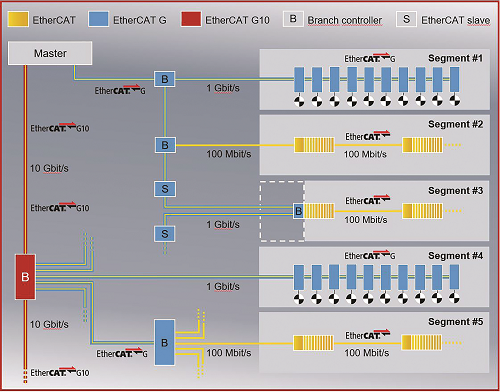ETG officially supports EtherCAT G
December 2019
Fieldbus & Industrial Networking
The Technical Committee of the EtherCAT Technology Group (ETG) has accepted EtherCAT G as an addition to the EtherCAT standard. Moving forward, EtherCAT G, which extends EtherCAT technology to 1 and 10 Gb/s, respectively, will be supported and promoted by the ETG.
EtherCAT G was introduced by Beckhoff Automation in 2018 as an extension of the EtherCAT standard. Beckhoff recently presented the gigabit technology addition to the ETG, and after thorough review, the organisation’s Technical Committee accepted it. Dr Guido Beckmann, chairman of the ETG Technical Committee, explains: “EtherCAT is already the fastest industrial Ethernet fieldbus, and will remain so due to its special functional principle. With EtherCAT G, particularly data-hungry applications, such as machine vision and high-end measurement technology, can now also be integrated, which extends the range of applications.”
The well-known 100 Mb/s EtherCAT technology remains the proven solution for the majority of applications. However, EtherCAT G offers additional user advantages, especially in applications where particularly large amounts of process data must be transported per device. This can include, for example machine vision, high-end measurement technology or complex motion applications that go beyond the scope of classic drive control. Existing devices designed for 100 Mb/s can be seamlessly integrated into an EtherCAT G system, and EtherCAT G devices in a 100 Mb/s EtherCAT system behave like classic EtherCAT devices.

The central element of EtherCAT G is the use of EtherCAT Branch Controllers, which essentially fulfil two functions: On the one hand, they act as a node for the integration of segments from 100 Mb/s devices; while on the other, they enable parallel processing of the connected EtherCAT segments. This significantly reduces the propagation delay in the system, which increases system performance.
The integration of EtherCAT G is simple as the extension is fully compatible with the IEEE 802.3 Ethernet standard, and no software adaptions in controllers are required standard modes. “The advantages of EtherCAT are well known and include processing on the fly, comprehensive diagnostics, simple configuration and integrated synchronisation,” concludes Beckmann. “These attributes are of course fully retained when EtherCAT G is used.”
Further reading:
PC-based control for flat wire motors for electric vehicles
Beckhoff Automation
Fieldbus & Industrial Networking
Special machine manufacturer, ruhlamat Huarui Automation Technologies unveiled the second generation of its mass production line for flexible stators with bar winding. This enables extremely short production cycle and line changeover times, supported by PC- and EtherCAT-based control technology from Beckhoff.
Read more...
Case History 200: The final case history – desuperheater control problem.
Michael Brown Control Engineering
Editor's Choice Fieldbus & Industrial Networking
For this final article I have chosen to relate a problem that existed in a desuperheater temperature control on a boiler in a petrochemical refinery.
Read more...
PC-based control technology in additive manufacturing
Beckhoff Automation
Editor's Choice Fieldbus & Industrial Networking
As an open control platform, PC-based control supports different engineering approaches, including low-code programming. The machine builder, Additive Industries uses this to create the code for the TwinCAT runtime of its 3D printers.
Read more...
Suppression and safety solutions for fire and gas in mission-critical industries
Fieldbus & Industrial Networking
By representing world-leading brands and focusing on fully integrated, certified systems, HMA South Africa is positioning itself as a trusted partner in fire detection, suppression and explosion-proof safety solutions across the continent.
Read more...
Integrating fire alarm systems into building management systems
Beckhoff Automation
Fieldbus & Industrial Networking
Fire alarm systems work independently of the building automation system. Schrack Seconet has developed a flexible gateway using ultra-compact industrial PCs and TwinCAT from Beckhoff, which can be used to flexibly convert a customer-specific communication protocol to a wide range of transmission standards.
Read more...
Premium unmanaged industrial switch
Vepac Electronics
Fieldbus & Industrial Networking
Premium unmanaged industrial switch for long-distance, noise-free fibre connectivity
Read more...
Fire and gas suppression solutions for mission-critical industries
Fieldbus & Industrial Networking
By representing world-leading brands and focusing on fully integrated, certified systems, HMA South Africa is positioning itself as a trusted partner in fire detection, suppression and explosion-proof safety solutions across the continent.
Read more...
The future of manufacturing
Fieldbus & Industrial Networking
Industrial automation is evolving at an unprecedented pace. At the forefront of this transformation is the Siemens SIMATIC ET 200SP HA Distributed I/O system. This is a flexible and scalable distributed I/O system for modern signal transfer from the field to the control level.
Read more...
Time-sensitive networking
RJ Connect
Editor's Choice Fieldbus & Industrial Networking
In this article, we will explore what is driving the rise of time-sensitive networking, how it is reshaping industrial efficiency, the challenges when deploying this technology, and ways to tackle these challenges.
Read more...
Loop Signature 30: Nonlinearity in control loops (Part 1)
Michael Brown Control Engineering
Editor's Choice Fieldbus & Industrial Networking
If nonlinearity occurs it means that if one is to carry on controlling with the same response to changes in load or setpoint, then the tuning of the controller will also need to be adjusted to meet the new conditions.
Read more...


